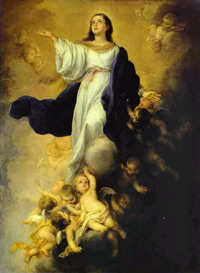 |
The Assumption of the Virgin Bartolomé Esteban Murillo, 1670s |
A silversmith named Demetrius, who made silver shrines of Artemis...called together [his fellow silversmiths and] workmen in related trades, and said: Men, you know we receive a good income from this business. And you see and hear how this fellow Paul has convinced and led astray large numbers of people here in Ephesus and in practically the whole province of Asia. He says that man-made gods are no gods at all. There is danger not only that our trade will lose its good name, but also that the temple of the great goddess Artemis will be discredited, and the goddess herself, who is worshipped throughout the province of Asia and the world, will be robbed of her divine majesty. When they heard this, they were furious and began shouting: Great is Artemis of the Ephesians! (Acts 19: 24-28)
Built around 550 BCE, the Temple of Artemis at Ephesus was one of the seven wonders of the ancient world. As this extract from the New Testament shows, early Christianity came into conflict with the worship of this highly regarded goddess. The history of Christianity is full of incidents where local deities and shrines were absorbed into the new religion, and it can hardly be seen as coincidence that it was at the Council of Ephesus in 431 CE that the title of Theotokos—‘Mother of God’—was officially conferred upon Mary.
In 451, when the Emperor asked the patriarch of Jerusalem to bring her relics to Constantinople to be enshrined in the capitol, the patriarch replied that there were no such relics, that “Mary had died in the presence of the apostles; but her tomb, when opened later...was found empty and so the apostles concluded that the body was taken up into heaven.”
Although both the Roman Catholic and the Eastern Orthodox Churches commemorate Mary’s passage into heaven on 15 August, the festival is called the Assumption of the Blessed Virgin Mary by Roman Catholics and the Dormition* of the Theotokos by the Orthodox. A common subject of paintings in the middle ages, the idea of the assumption of Mary into heaven after her death is first expressed in narratives of the fifth and sixth centuries; however this was not formally defined as a dogma until 1950, when Pope Pius XII proclaimed: “The Immaculate Mother of God, the ever-virgin Mary, having completed the course of her earthly life, was assumed body and soul into heaven.”